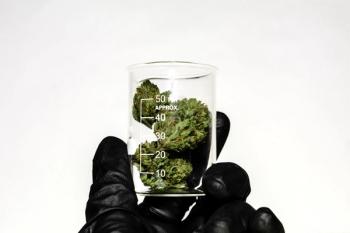
Cannabis Science and Technology
- September/October 2019
- Volume 2
- Issue 5
Up in Smoke: The Naked Truth for LC–MS/MS and GC–MS/MS Technologies for the Analysis of Certain Pesticides in Cannabis Flower
A study using LC-qTOF, GCqTOF, and GC–MS/MS to evaluate the selectivity of a model pesticide commonly found in regulatory target lists.
In U.S. states, Canada, and other countries where medicinal or adult recreational cannabis has been legalized, regulatory entities require a panel of chemical and biological tests to assure quality and safety of the products prior to retail sales. Of the required assays, residual pesticide identification and quantification is arguably the most challenging. The reason for this is the complexity of the cannabis genome that synthesizes phytocannabinoids, terpenes, polyphenols, lipids, and a host of other endogenous chemicals. It is not unusual for today’s selectively bred and cloned cannabis to contain 20–30% ∆9-tetrahydrocannabinol (THC) and other cannabinoids such as cannabidiol (CBD), and 1–3% terpenoids by dry weight. These chemicals alone constitute hundreds of milligrams per gram of sample. In contrast, residual pesticides are typically measured in the 10–1000 ng/g (ppb) range. Pesticide analysis in this matrix requires tandem quadrupole mass spectrometry (MS/MS) because of its mitigation of chemical noise through MS/MS processes. Notwithstanding the power of MS/MS, there are many cases where isobaric interferences effect quantitative results and therefore selectivity becomes as important as sensitivity. In this study, we used liquid chromatography and gas chromatography quadrupole time-of-flight mass spectrometry (LC-qTOF and GC-qTOF, respectively), and gas chromatography tandem mass spectrometry (GC–MS/MS) to evaluate the selectivity of a model pesticide commonly found in regulatory target lists. The LC-qTOF system used negative ion-atmospheric pressure chemical ionization (NI-APCI), and the GC–MS systems used electron ionization (EI). Through this work, we demonstrated that the GC–MS precursor ion and product ion pairs are highly specific derivatives of the parent molecule while the NI-APCI precursor ion is a nonspecific chemical species created in situ through a complex ionization mechanism. In this latter case, all precursor ion and product ion pairs are not selective for the intact analyte molecule.
The legalization of medicinal and recreational marijuana in some U.S. states has resulted in legislation mandating safety and quality testing prior to retail sale. These regulations include analytical chemistry and biological assays to identify and quantify cannabinoids such as tetrahydrocannabinol (THC), residual pesticides, mycotoxins, heavy metals, residual manufacturing solvents, terpenes, and microbial contaminates. In the U.S., marijuana (as defined by a Cannabis spp. THC concentration >0.3% [dry wt/wt]) remains an illegal, Schedule I narcotic at the federal level. Therefore, there is no federal guidance for proper safety testing of the consumer products, and this has resulted in each U.S. state defining unique chemical target lists and action levels. This is not the case in Canada where the federal government has defined the action levels for a target list of 96 pesticides.
In the U.S., the lack of interstate harmony has created many challenges for cannabis testing laboratories. Most conspicuously are the various state residual pesticide lists that can range from a couple dozen with relatively high action levels to more than 60 with relatively low action levels. The Venn diagram in Figure 1 illustrates the varied nature of four U.S. state pesticide lists.
Further complicating the issue is the inclusion of pesticides not amenable to electrospray ionization (ESI): the most common liquid chromatography–tandem mass spectrometry (LC–MS/MS) ionization source for this analysis. For example, Canada, California, Nevada, Pennsylvania, Florida, and other U.S. states have included pentachloronitrobenzen (PCNB), captan, cis/trans-chlordane, chlorfenapyr, or methyl parathion in their respective target lists. These compounds are known “bad actors” when analyzed via LC–MS/MS using ESI. To overcome this issue for compounds like PCNB, the relevant literature space has proposed using negative ion-atmospheric pressure chemical ionization (NI-APCI) LC–MS/MS. For example, the analysis of PCNB using NI-APCI LC–MS/MS has been shown elsewhere with a precursor ion of 275.5 m/z and a mechanism of ionization reported as the loss of HCl followed by formation of an ammonium ion adduct (1). There are two intrinsic problems with this description: First, the empirical formula for PCNB is C6Cl5NO2 thus there is no hydrogen atom to lose as H-Cl, and second the formation of a positively charged ammonium ion in negative ionization mode is highly unlikely. Even if it were correct, the above description defeats a primary function of soft ionization: the formation of a specific ion representing the intact molecule. Please note, these authors do not debate the presence of a detectable MS/MS transition for PCNB in NI-APCI LC–MS/MS, but the lack of specificity and nonlinear response that has been shown in the literature are problematic for the accurate, precise, and robust identification and quantification of PCNB in complex cannabis matrices.
Materials and Methods
Chemicals and Standards
PCNB and high purity acetonitrile were obtained from Sigma. Ground cannabis flower was obtained from the University of Mississippi Marijuana Project with permission from the U.S. Drug Enforcement Administration (DEA).
Analysis
Agilent 1290/6545 LC-QTOF, 7890/7250 GC-QTOF, and 7890/7010 GC–MS/MS systems were used for all analyses. Both QTOF systems were operated in high-resolution-accurate mass (HRAM) mode for MS and MS/MS experiments.
Instrument Configurations
The LC-QTOF system was configured with an APCI source in negative ionization mode, and a 3.0 mm x 100 mm, 2.7 µm semiporous particle size phenylhexyl column. The mobile phases were: A) 2 mM ammonium formate and 0.1% formic acid (v/v) in LC–MS grade water and B) 2 mM ammonium formate and 0.1% formic acid (v/v) in LC–MS grade methanol. The GC-QTOF was configured with a split–splitless inlet, a 30 m DB-35MS UI column, and helium carrier gas. The GC–MS/MS system was configured with a multimode inlet (MMI) operated in cold splitless mode, two HP-5MS UI columns connected through a purged union, and helium carrier gas. Both GC mass spectrometers were operated in electron ionization (EI) mode at 70 eV.
Sample Preparation
For the LC-QTOF and GC-QTOF experiments, 1 µg/mL PCNB in acetonitrile was injected into the systems, and both MS and MS/MS data were collected. For the GC–MS/MS experiments, dry cannabis flower containing 20–30% THC by dry weight was spiked at five calibration levels over the range of 8–120 ppb in vial (200 ppb [0.2 μg/g] to 6250 ppb [6.25 μg/g] in matrix). Extracts were prepared by solid-phase extraction (SampliQ C18 EC SPE Cartridge, Agilent) with acetonitrile to a final dilution factor of 25:1. The extraction process is given in Figure 2.
Results and Discussion
NI-APCI LC-QTOF
The ionization mechanisms of NI-APCI are (2):
- Electron capture: M + e- → M.-
- Dissociative electron capture: M + e- → F1- + F2.
- Proton abstraction: M + OH- → (M-H)- + H2O
- Anion adduction: M + A- → MA-
Chlorinated nitrobenzene compounds like PCNB have been shown to form phenoxide ions under negative atmospheric pressure ionization conditions (3). Therein, the predominant ionization mechanism for the formation of (M – Cl + O)- was described as electron capture of O2 to form superoxide O2- followed by an in-situ reaction with the neutral molecule and dissociative electron capture to form the ionized species. The general reaction scheme was proposed as:
O2- + M → (MO2)- → (M – Cl + O)- + OCl.
More specifically, for PCNB this is illustrated in Reaction Scheme 1.
A secondary ionization mechanism is also observed that forms pentachlorobenzyl phenoxide. The putative secondary ionization mechanism is: Reaction scheme 1 followed by dissociative electron capture (NO2-) and anion adduction (Cl-). This is illustrated in Reaction Scheme 2.
Although the molecular species formed in Reaction Scheme 1 can occur at both the ortho and the para positions of PCNB, Reaction Scheme 3 suggests the ortho position is favored based on the collision-induced dissociation (CID) species formed through the MS/MS processes.
GC-QTOF HRAM MS and MS/MS
The GC-QTOF HRAM MS spectrum and isotopic fidelity of the PCNB ion [C6Cl5NO2]+ are given in Figure 3. The mass accuracy was within 0.06 ppm and isotope abundance and spacing was well correlated with the theoretical prediction. Table I illustrates the primary MS fragmentation cascade. Each ion species was identified by HRAM MS and the measured mass accuracy was less than 1.2 ppm for all ion species except for C6Cl5N+. This ion fragment, which represents the loss of O2, yielded a relative ion abundance of <100 counts. Therefore, the ion statistics were not enough for good mass accuracy under the given data acquisition parameters.
GC–MS/MS
Table I identifies the precursor ion species used for GC–MS/MS MRM data acquisition. Figure 4 illustrates the ion species of the primary ion fragments. In Figure 5, the EI HRAM MS/MS spectra are shown for three precursor ions. Figure 6 illustrates the GC–MS/MS multiple-reaction monitoring (MRM) chromatogram for the PCNB quantifier and qualifying ions at 8 ppb in 20–30% cannabis flower extract matrix, and the linear calibration curve over the range of 8 ppb through 250 ppb in vial. Table II defines the MRM transitions used for the GC–MS/MS work and Table III illustrates the summary statistics over the same calibration range.
Conclusion
This work illustrates that NI-APCI LC–MS/MS uses nonspecific precursor ion and product ion pairs (MRM). Moreover, according to reference 1, a four-point quadratic calibration curve yields a regression coefficient (r2) <0.97 which is not permissible under California statute that requires a quadratic calibration curve to have at least six calibration levels with r2 >0.99.
In EI GC–MS/MS, every precursor ion is a direct fragment of PCNB. The MRM transitions are more than 3.5 times more selective when compared to NI-APCI LC–MS/MS. When measured in cannabis matrix, these specific MRM transitions are linear and more than 10-fold more sensitive than reported in NI-APCI LC–MS/MS methodologies. The take away point is that specificity is just as important as sensitivity and in this example of a model compound such as PCNB, the NI-APCI LC–MS/MS transitions are not selective for PCNB and fail to meet California regulatory requirements. Conversely, GC–MS/MS in EI affords the accurate, precise, and robust identification and quantification of PCNB and other pesticides not amenable to ESI in complex cannabis matrices that meets and exceeds regulatory statute.
Disclaimer
Agilent products and solutions are intended to be used for cannabis quality control and safety testing in laboratories where such use is permitted under state and country law.
References:
- D. Tran, et al. Document number: RUO-MKT-02-7607-A. 2018, AB Sciex, Framingham, MA.
- C.N. McEwena and B.S. Larsen, J .Am. Soc. Mass Spectrom. 20, 1518–1521 (2009).
- I. Dzidic, D.I. Carroll, R.N. Stillwell, and E.C. Horning, Anal. Chem.47(8), 1308–1312 (1975).
Matthew Curtis, Eric Fausett, Wendi A. Hale, Ron Honnold, Jessica Westland, Peter J. Stone, and Jeffery S. Hollis are with Agilent Technologies in Santa Clara, California. Anthony Macherone is with Agilent Technologies and The Johns Hopkins University School of Medicine in Baltimore, Maryland. Direct correspondence to:
How to Cite This Article
M. Curtis, E. Fausett, W.A. Hale, R. Honnold, J. Westland, P.J. Stone, J.S. Hollis, and A. Macherone, Cannabis Science and Technology2(5), 56-60, 70 (2019).
Articles in this issue
about 6 years ago
Using Gas Chromatography for Accurate Terpene Analysis in Cannabisabout 6 years ago
Quality Control in the World of Cannabisabout 6 years ago
Hemp Testing Insanityabout 6 years ago
Medical Cannabis for Analgesia: Growth and Developmentabout 6 years ago
Is Your Cannabis Testing Laboratory Ready for ISO/IEC 17025:2017?Newsletter
Unlock the latest breakthroughs in cannabis science—subscribe now to get expert insights, research, and industry updates delivered to your inbox.




